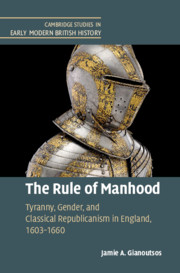Conclusion
Published online by Cambridge University Press: 26 January 2021
Summary
Early modern Englishmen, steeped in the reading of classical history, saw extensive connections between the distant past and their political present. History unveiled repeating patterns of constitutional change – from monarchy to tyranny, aristocracy to oligarchy, democracy to ochlocracy and back again – as humanists inspired by Polybius regularly described. By attending to these patterns, and by frequently drawing upon the moralising tales of good governance and tyranny found in these histories, seventeenth-century writers and readers conceptualised and articulated their duties and the duties of others in the political arenas of battlefield, household, senate house, and palace. As we have seen, this early modern grammar of historical discourse placed gender at the heart of political thinking. It forged debate and conflict through affording Englishmen a language to counsel, to warn, and to criticise those who ruled over them. It provided significant images of tyranny which eroded support for the Stuart monarchs and thereafter also for Oliver Cromwell. And relatedly, it offered an historical account of England grounded not in the island’s dynastic history since William the Conqueror but in the more expansive rise and fall of classical empires, revolutions, and heroes. Simultaneously, this gendered and historical discourse provided the urgency for, and the central foundation of, English republican thought both before and during the English Revolution, as Englishmen sought to repair the emasculating effects of tyranny through republican solutions.
- Type
- Chapter
- Information
- The Rule of ManhoodTyranny, Gender, and Classical Republicanism in England, 1603–1660, pp. 353 - 369Publisher: Cambridge University PressPrint publication year: 2020



